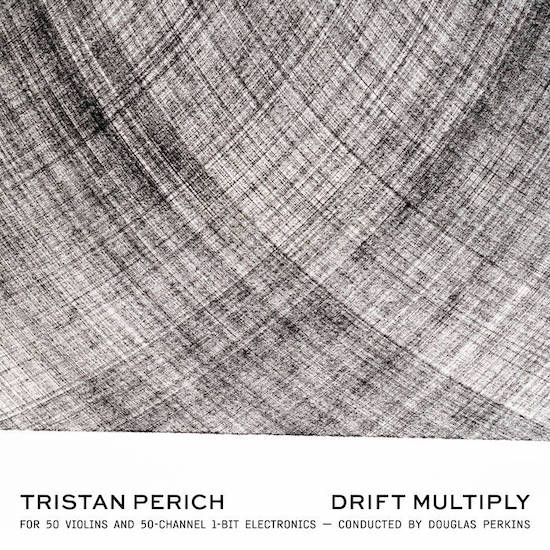At certain points over his career, composer Tristan Perich seemed to fall victim to the success of visual artist and thinker Tristan Perich. Thanks to 2007’s 1-Bit Music, 2010’s 1-Bit Symphony, and 2016’s Noise Patterns, his work became synonymous with compositions for one-bit circuits embedded into practical jewel cases, complete with audio jacks and play/stop/previous/next controls. But even before you plugged in your headphones and interacted with them, these objets d’art demanded attention. Striking and strikingly functional, their bare innards were presented like a vivisection of chips, batteries, buttons, and wires. In a way, they were exploded then suspended electronic pianolas capable of simultaneously reproducing and eclipsing Perich’s music whenever and forever.
The New York-based artist has expanded his approach since, breeding and multiplying the one-bit devices and melding them with acoustic instruments. Drift Multiply continues this strain of work first explored on his collaboration with pianist Vicky Chow on 2014’s Surface Image. Marching beyond the fascination with the minimal computer and assembling an even grander ensemble, he employs a fifty strong orchestra of one-bit electronics – each coupled to a single speaker – and adds to them fifty violinists under the baton of Douglas Perkins. While his signature micro musical boxes are inescapable, their phenomenology feels shifted as individual characters are now leveraged for the good of the collective. Demoted to the role of “mere” instruments, they become interchangeable companions to violins – existing on equal footing and speaking the same dialect.
The novelty of the instrumentation thus takes a step back and lets Perich’s elegant sense of composition breathe. While made from individually minimal, looping rhythms and uncomplicated textures, Drift Multiply is rendered into a harmonically luxurious and sonically dense whole. Here, violins and electronics adopt similarly raw timbres and trace narrow and glossy lines. These often take the shape of shortened phrases and sharp needles, whether streaming with sustained glissandos, bouncing along detachés, or oscillating with resounding synthesised arpeggios.
During an especially intriguing part of ‘Section 3’, a crescendo of violin glimmer is interspersed with ringtone-like noises, only for them to forget their identities. Suddenly, violins chatter digitally, playing brief broken chords as if communicating in Morse code, while the swarm of electronic sounds swells lusciously, akin to a string ensemble during a fortissimo.
Elsewhere, Perich finds shy polyphonies and revisits noise aesthetics through the additive interactions of his primordial synthesisers. On ‘Section 5’, a sea of electroacoustic sighs drones in unison, then coalesces into a hum, gently rising up and harshly crashing down like huge, engulfing waves of static around the fragile glide of violins. And while each violin and each one-bit chip buzz happily along their own melodic lines, it’s their collective sway that makes the music compelling. Simultaneously, rhythms become implicit, caused by continuous patterns of repetitive pitches, indebted to the shared acute edges of the violin and one-bit tones, and helped by Perkins’s percussionist background.
While the physical existence of Perich’s work has always invited philosophical and conceptual questions about the relationship between art and technology, the organic and the electronic, his compositional process often remained secluded. On a material level, the dark epoxy resin and silicon of the controller chip hid the composer’s intricate scores notated as program code. On a musical level, instead of being recognised as an authentic devotee of minimalism – “I think of it more as writing for simple voices”, he revealed to The Wire’s Kurt Gottschalk in 2008 – he was painted as a verbatim follower of Philip Glass and Steve Reich. Drift Multiply dispels all these notions and reveals what was always there – an astute sense of composition. One in which tone generators both acoustic and electric are made to weave and wave intense tapestries. To paraphrase Perich’s own words, beautiful things come out of biomechanical systems.


